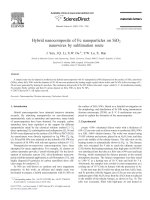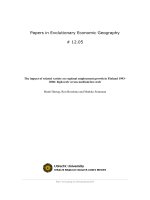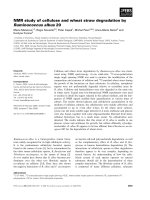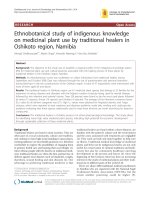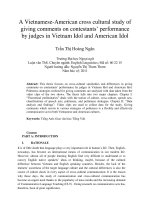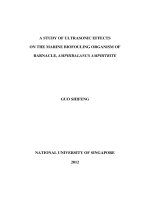Study of oxide film on copper electrode by in situ photothermal spectroscopy
Bạn đang xem bản rút gọn của tài liệu. Xem và tải ngay bản đầy đủ của tài liệu tại đây (4.4 MB, 126 trang )
STUDY OF OXIDE FILM ON COPPER ELECTRODE BY
IN SITU PHOTOTHERMAL SPECTROSCOPY
LI HONGMIN
(B.Sc. Fudan University)
A THESIS SUBMITTED
FOR THE DEGREE OF DOCTOR OF PHILOSOPHY
DEPARTMENT OF CHEMISTRY
NATIONAL UNIVERSITY OF SINGAPORE
2003
I
ACKNOWLEDGMENTS
I would like to thank my supervisor, Associate Professor Siow Kok Siong, for his
invaluable guidance and support throughout the course of this work.
I would also like to thank Prof. Jiang Zhiyu, Department of Chemistry, Fudan University,
for his advice and discussion in various field of Electrochemistry.
Thanks especially to Associate Professor Shen Ze Xiang, Department of Physics, for his
help in using laser as a light source. My appreciation is extended to the staff in the
Department of Chemistry, especially Miss Tang and Mdm Lin; Department of Biological
Science, especially Mdm Loy; Physics Department, especially Mr. Ten for their technical
assistance in various experiments.
Many thanks to my colleagues and friends, particularly Dr. Wang Hongbing, Dr. Gu
Hong, Dr. Gao Yuejing, Dr. Xu Wu, Dr. Hou Xinping, Ms. Xie Hong, Miss Cao Qing and
Mr. Sheng Zhong, for their friendship, help and discussion.
The Research Scholarship from the National University of Singapore over the last three
years is grateful acknowledged.
Last, I would like to thank the fully support from my wife, son and my parents, their love
and encouragement were a great help during this research program. It is absolutely
impossible for me to complete the experiments and writings without their understanding and
help as a family.
II
Contents
List of figures
List of tables
Summary
Chapter 1 General Introduction
1.1 In Situ Characterization of Electrochemical Process
1.1.1 Overview
1.1.2 Ellipsometry
1.1.3 Surface-Enhanced Raman Spectroscopy
1.1.4 Ultraviolet-Visible Reflectance Spectroscopy
1.1.5 Infrared Reflectance Spectroscopy
1.1.6 Surface X-Ray Absorption Spectroscopy
1.1.7 Photothermal Deflection Spectroscopy
1.1.8 Scanning Tunneling Microscopy
1.2 Photoacoustic Spectroscopy
1.2.1 Introduction
1.2.2 Principles
1.2.3 Experimental Setup
1.2.4 Applications
III
1.3 Photocurrent Spectroscopy
1.3.1 Introduction
1.3.2 Theory
1.3.3 Experimental
1.3.4 Examples
1.3.5 Conclusion
1.4 References
Chapter 2 In Situ Photothermal Spectroscopy of Oxide Film on
Copper Electrode in NaOH Solution
2.1 Introduction
2.2 Experimental
2.2.1 Experimental Setup
2.2.2 PTS Cell
2.2.3 Chemicals
2.3 Results and Discussion
2.3.1 Theoretical Model
2.3.2 PTS Spectrum
2.4 Conclusions
2.5 References
IV
Chapter 3 A Study of Thermal Effect in Photocurrent Measurement
on Copper Electrode in NaOH Solution by In-situ
Photothermal Spectroscopy Method
3.1 Introduction
3.2 Experimental
3.2.1. PTS spectrum
3.2.2. Thermal effect in photocurrent measurement
3.2.3 Chemicals
3.3 Results and Discussion
3.3.1. PTS spectrum
3.3.2. Thermal effect in photocurrent measurement
3.4 Conclusions
3.5. References
Chapter 4 The Oxide Film on Copper Electrode in NaOH Solution:
Photoelectrochemical Study
4.1 Introduction
4.2 Experimental
4.2.1 PEC Measurement
4.2.2 Photoelectrochemical Properties Measurement
V
4.2.3 Chemicals
4.3 Results and Discussion
4.3.1 Photocurrent spectrum
4.3.2 Photocurrent Dependence on the Photon Energy of Incident Light ((E
g
)
4.3.3 Photocurrent Dependence on the Potential (φ
fb
)
4.4 Conclusions
4.5 Reference
Chapter 5 The Oxide Film on Copper Electrode in NaOH Solution:
XPS and ERD Studies
5.1 Introduction
5.2 Experimental
5.2.1 Electrochemical Cell and Cyclic Voltammetry
5.2.2 XPS and ERD
5.2.3 Chemicals
5.3 Results and Discussion
5.3.1 PTS spectrum and cyclic voltammogram
5.3.2 XPS
5.3.3 ERD
5.4 Conclusions
5.5 References
VI
Chapter 6 The Oxide Film on Copper Electrode in NaOH Solution:
Voltammetry and SEM Studies
6.1 Introduction
6.2 Experimental
6.2.1 Voltammetry
6.2.2 SEM
6.2.3 Chemicals
6.3 Results and Discussion
6.3.1 Voltammetry
6.3.2 SEM
6.4 Conclusions
6.5 Reference
VII
List of Figures
Figure 1.1 A basic PDS system
Figure 1.2 Schematic diagram of (a) the photoacoustic cell and (b) the experimental
arrangement
Figure 1.3 PAS cell with microphone as detector
Figure 1.4 (a) Diagram of the double-beam PAS setup and (b) PAS cell with
microphone
Figure 1.5 Schematic representation of an illuminated p-type (a) and n-type (b) passive
film under depletion conditions and of an insulating film under flat band
conditions with a simultaneous excitation in the film (hv
1
) and in the
underlying metal (hv
2
) (c).
Figure 1.6 Schematic representation of an experimental set-up for
photoelectrochemical studies of passive films
Figure 1.7 Photocurrent spectrum of the passive film on copper electrode after
reduction of the CuO/Cu(OH)
2
film
Figure 2.1 Block diagram of the photothermal spectroscopy system
Figure 2.2 Electrochemical cell
Figure 2.3 Relationship between ∇ and
d
a
2
1
1
)
2
(exp
ω
ω
−
−
. λ = 488.0 nm, d = 25um
Figure 2.4 Relationship between ∇ and f. λ = 488.0 nm, d = 0.0025cm
Figure 2.5 Relationship between lg ∇and specimen thickness d (d = N x 0.0025cm). N
is the number of copper foils, λ = 488.0 nm, and f = 10 Hz
Figure 2.6 Cyclic voltammogram (a) and PTS spectrum (b), on copper electrode in
0.1M NaOH. Potential scan rate = 5mv/s, f = 10 Hz, λ = 488.0 nm.
Figure 3.1 Diagram of measurement of (a) PTS and photocurrent response, (b) thermal
effect in photocurrent measurement
Figure 3.2 PTS spectrum (a), Cyclic voltammogram (b), Total photocurrent (c),
Thermal current (d), and Real component of photocurrent (e) on copper
electrode in 0.1M NaOH. Potential scan rate = 5mv/s, f = 10 Hz, λ = 488.0
nm, p = 200 mw
VIII
Figure 4.1 Cyclic voltammogram (a), Total photocurrent (b), and Real component of
photocurrent (c) on copper electrode in 0.1M NaOH.
Potential scan rate =
5mv/s, f = 10 Hz, λ = 488.0 nm, p = 200 mw.
Figure 4.2 On and Off current
Figure 4.3 Photocurrent dependence on photon energy of incident light, R = 1kΩ
Figure 4.4 Photocurrent dependence on potential, λ = 488.0 nm, p = 380 mw, R = 1kΩ
Figure 5.1 Schematic illustration of the ERD experimental arrangement
Figure 5.2 Schematic diagram of the experimental apparatus of ERD analysis
Figure 5.3 Cyclic voltammogram on copper electrode in 0.1M NaOH.
Potential scan
rate = 5mv/s
Figure 5.4 XPS spectra of oxide film formed at potential of (a) anodic peak I, (b)
anodic peak II, and (c) anodic peak III.
Figure 5.5 ERD spectrum of film formed at potential of anodic peak III
Figure 6.1 Cyclic voltammetry in different potential window on copper electrode in
0.1 N NaOH solution, (a) –1150 to –400 mv, (b) –1150 to –200 mv, (c) –
1150 to 100 mv, and (d) –1150 to 450 mv, potential scan rate = 5 mv/s
Figure 6.2 Linear potential sweep reduction for oxide layer formed in –240 mv for (a)
5 min, (b) 15 min, (c) 30 min, and (d) 60 min on copper electrode in 0.1 N
NaOH solution, potential scan rate = 5 mv/s.
Figure 6.3 Linear potential sweep reduction for oxide layer formed in +100 mv for (a)
5 min, (b) 15 min, (c) 30 min, and (d) 60 min on copper electrode in 0.1 N
NaOH solution, potential scan rate = 20 mv/s from 100 to –350 mv and 5
mv/s from –350 to –1150 mv.
Figure 6.4 SEM x5000 of oxide layer formed on copper electrode in 0.1 N NaOH
solution for same time of 5 min at different potential of (a)-peak I, (b)-peak
II, (c)-peak III; and 120 min of (d)-peak I, (e)-peak II, (f)-peak III
Figure 6.5 SEM x5000 of oxide layer formed at potential of peak I on copper electrode
in 0.1 N NaOH solution for different time, (a) 5 min, (b) 15 min, (c) 30 min,
(d) 60 min, and (e) 120 min
Figure 6.6 SEMx5000 of oxide layer formed at potential of peak II on copper
electrode in 0.1 N NaOH solution for different time, (a) 5 min, (b) 15 min,
(c) 30 min, (d) 60 min, and (e) 120 min
IX
Figure 6.7 SEM x5000 of oxide layer formed at potential of peak III on copper
electrode in 0.1 N NaOH solution for different time, (a) 5 min, (b) 15 min,
(c) 30 min, (d) 60 min, and (e) 120 min
X
List of Tables
Table 2.1 Value of ∇ at different ω, λ = 488.0 nm, d = 0.0025 cm
Table 2.2 Value of
d
a
2
1
)
2
(exp
ω
− at different f, λ = 488.0 nm, d = 0.0025 cm
Table 2.3 Value of lg∇ at different N. N is the number is copper foil, λ = 488.0 nm, f
= 10 Hz
Table 4.1 Photocurrent dependence on photon energy of incident light, R = 1kΩ
Table 4.2 Photocurrent dependence on potential, λ = 488.0 nm, p = 380 mw, R = 1 kΩ
Table 5.1 Cu2p
3/2
and O1s binging energies of separate peak and related compounds
XI
Summary
The behavior of an oxide film on a copper electrode in a 0.1 N NaOH solution has been
studied by the in-situ photothermal spectroscopy (PTS) method using a polyvinylidene
difluoride (PVDF) pyroelectric film as a thermal detector. This study is complemented by
photocurrent spectroscopy, XPS, ERD, and cyclic voltammetry methods.
By PTS study, a simple one-dimensional heat transport model is chosen as a theoretical
model to analyze the photothermal signal and has been partly proved by some experiments.
The photothermal response varies linearly with film thickness and inversely proportional to
the chopping frequency f.
From the variations of the
PTS signal, the redox reaction of copper surface layers
between Cu, Cu
2
O, and CuO/Cu(OH)
2
at different potentials was observed. This proved that
the
PTS method using PVDF film as thermal-detector is a very sensitive and fast response
method for measuring surface changes. This
PTS method has the advantages of simplicity
and versatility. It allows a more flexible sample cell arrangement and is free from external
acoustic noise, comparing with
PAS method.
The thermal effect in photocurrent measurement on copper electrode in 0.1M NaOH
solution has also been studied by photothermal spectroscopy (
PTS) method. That part of the
photocurrent response due to thermal effect has been separated from the total photocurrent
response, and the real part of photocurrent response due to photo effect has been obtained by
deducting I
th
from I
total
.
XII
By photocurrent study, the Cu
2
O layer is p-type and band gap energy is about 2.43 eV by
the experiment of photocurrent dependence on photon energy of incident light. The flat band
potential is about 0.3 mv by photocurrent spectrum and –341mv. The difference may be due
to the deviation between theoretical equation and practical situation.
XPS and ERD study were performed on the surface oxide layer which formed at
different potential corresponding to the anodic voltammetric peak.
XPS result shows that
CuO layer was formed round the anodic peak II, and a duplex layer of CuO and Cu(OH)
2
was formed round the anodic peak III. The element H in surface layer formed at potential
round the anodic peak III could be detected by
ERD.
The cyclic voltammetry at different potential window was carried out on Cu electrode in
0.1 N NaOH solution. The results that peak I corresponds to the simple oxidation of Cu
2
O
from Cu, peak II corresponds to the formation of CuO from Cu
2
O and direct from Cu, and
peak III corresponds to the formation of duplex layer of Cu(II). Another experiment where
the oxide layer formed at constant potential of peak II and III was cathodic scanned back to
–1150 mv was performed. The result shows, combined with
SEM on the surface layer
formed in different potential for different time, that the major formation at peak I and III is
completed within 15 min, while in peak II, the surface coverage increase with the time
increasing and the major phase is CuO which was formed direct from Cu.
1
Chapter 1
General Introduction
1.1 In Situ Characterization of Electrochemical Process
1.1.1 Overview
The infusion of multidisciplinary interest in electrochemical research in the recent past
has given rise to new opportunities for innovation and research in application areas such as
electrocatalysis, electrodeposition, corrosion, batteries, fuel cells, and rapidly developing
semiconductor industrial. Alongside this, need for molecular level information on the
structure of the electrode-electrolyte interface, mechanism and kinetics of electrochemical
process on electrodes and electrolytes during the conduct of electrochemical reactions also
has clearly been identified.
The electrode-electrolyte interface, often called the interphase, is the heart of
electrochemistry. It is the site of enormous electric fields and chemical forces that determine
electrochemical reactions. It is also the site of electron transfer, from a region in which only
electrons move freely to a region where ions move freely and where electrons must travel
“piggyback” on some molecule. The electrode-electrolyte interphase is the region where the
properties of both phases differ from their bulk value. An essential element in understanding
this interphase is the use of in situ spectroscopic methods to directly obtain molecular
information about the interfacial region. Such techniques have not been as well developed
2
for the solid – liquid interface as they have been for the solid – gas (vacuum) interface,
which, in comparison, has been extensively studied. This is partly because there are many
sensitive surface techniques for the solid – vacuum interface, such as Auger electron
spectroscopy (
AES), ultraviolet and x-ray photoelectron spectroscopy (UPS and XPS),
secondary ion mass spectrometry (
SIMS), low-energy electron diffraction (LEED), and
high-resolution electron energy loss spectroscopy (
HREELS). However, such techniques
require ultrahigh – vacuum environments.
Although electrochemists can use electrochemical methods to study solid—liquid
interfacial processes, the electrochemically measurable parameters, such as current and
potential, yield information regarding only the rate of reaction, the influence of diffusion,
concentration, temperature, and so on. They cannot give information about the chemical
identity, structure, configuration, and orientation of surface species. Therefore, there is a
great need for techniques that can probe both kinetic and structural characteristics of a
surface reaction. Ideally, such a technique would be combination of an electrochemical
system with a spectroscopic method capable of being used in situ, that is, while
electrochemical process are taking place.
Following is the brief introduction to some of in situ spectroscopic techniques and their
applications.
1.1.2 Ellipsometry
3
Ellipsometry is an optical technique for characterizing surfaces and thin films. The
technique involves the reflection of polarized (generally monochromatic) light from the
surface under study and the measurement of the change in the state of polarization caused by
the reflection. The measurements usually involve elliptically polarized light, a fact that is
recognized in the present name of the technique, and yield two parameters that characterize
the change in the state of polarization.
Ellipsometer measurements are often extremely sensitive to the presence of very thin
surface layers (including fractional monolayers), to changes in their thickness (or coverage),
and to changes in surface topography at an atomic scale. The range of film thicknesses that
can be observed is very large (reaching to several wavelengths optical thickness), and the
surfaces being studied may be immersed in any optically transparent medium, including
liquids. These characteristics make the use of ellipsometry for electrochemical studies
particularly attractive.
Although the reflection of polarized light has been studied for more than a century, as
pointed out in the historical review by Hall [1], the term ellipsometry was not introduced
until 1945, by Rothen [2], who described in his recollections [3] that he thought the
otherwise appropriate term, Polarimetry, had been given a restricted meaning by chemists
for the measurement of optical rotation. Significant early work by Vasicek employed the
terms polarimetry or polarization spectroscopy [4,5].
4
The applications of ellipsometry cover a wide range of studies of electrochemistry, such
as anodic oxidation [6], gas-phase oxidation [7], corrosion [8,9], cathodic metal deposition
[10], reduction of oxides [11], adsorption process [12], electronic materials [13], and other
studies.
Ellipsometry will continue to be used for measurements on surfaces, particularly solid—
liquid and solid—gas interfaces, for which its capabilities are unique. It will provide real
time, in situ information on the formation, breakdown, and removal of surface layers or on
the cleaning, etching, and annealing of solids. The spectroscopic properties of bulk solids
and surfaces will be determined more readily to derive chemical composition, ordering,
electronic structure, and the distribution of materials in composite and inhomogeneous
systems.
The combination of ellipsometer measurements with other techniques will be of
continued interest for the detailed study of surfaces and thin films.
1.1.3 Surface-Enhanced Raman Spectroscopy
The Raman effect is due to the interaction of photons with the vibrations of chemical
bonds. These wavelengths are in the IR region but the excitation source for observation of
the Raman effect is often in the visible region. The major part of incident light passes
through the system without change of photon energy (Rayleigh effect); if there is energy
exchange with the system the Raman effect is observed.
5
In 1974, Fleischmann et al. [14] first reported the surface Raman spectra of pyridine
adsorbed on a silver electrode that had been electrochemically roughened. Fleischmann et al.
also gave a possible model for the structure of the double layer between the silver electrode
and its electrolyte solution contained pyridine and potassium chloride. These results were of
great interest since they showed that Raman spectroscopy could be used in situ to obtain
molecular information at an electrode surface. However, the fact that a giant surface
enhancement was occurring was not realized until 1977, as noted in the work of Jeanmaire
and Van Duyne [15] and Albrecht and Creighton [16]. They independently found that with
only a single pretreatment voltage pulse or triangular sweep, the Raman signal per adsorbed
pyridine molecule was roughly six orders of magnitude larger than that of an isolated
molecule in solution. Thus, the signal from pyridine that Fleischmann et al. [14] had
observed could not be attributed to only an increase in surface area of their roughened
electrode. This surprising discovery touched off a flurry of experimental and theoretical
activity. Since then
SER scattering and other interactions of EM radiation with surfaces
have been intensely studied.
The
SERS effect has been observed for many different interfaces and environments.
SER scattering in an electrochemical system, that is, electrode-electrolyte interface, has
been most widely investigated. Most
SER scattering studies have been obtained on silver
because silver shows the largest enhancement. Copper [17] and gold [18] have also shown
SERS enhancements. In addition, some form of enhanced surface scattering has been
claimed for platinum [19], nickel [20], aluminum [21], lithium and sodium [22-24], and
semiconductors [25]. However, the giant Raman enhancement effect that is commonly
6
referred to as SERS is mainly limited to the coinage metals. With all the various
possibilities for development in sensitivity, time resolution, the new
SERS active substrates,
it would appear that
SERS will continue to be a field of spectroscopy with a great amount of
activity.
1.1.4 Ultraviolet – Visible Reflectance Spectroscopy
Specular reflectance spectroscopy has much in common with ellipsometry and while in
theory it is a
less informative technique, in practice it is certainly more versatile and has
proved more useful to electrochemists. Its major advantages are its much faster response,
and therefore greater suitability in kinetic studies, its optical simplicity, and the ease with
which the wavelength may he varied. Like ellipsometry it has, until very recently, been
restricted to the
UV – visible spectral range and it is such studies that are discussed here.
Recent developments in the extension of this technique to the study of vibrational
spectroscopy will be considered later.
The essence of the reflectance spectroscopy experiment is to shine a monochromatic light
beam, that is also usually plane polarized, at a defined angle of incidence at an electrode
surface, and to measure the intensity of the reflected beam as a function of an experimental
variable such as wavelength, potential, or time. The same model as is used in ellipsometry,
i.e. substrate/interphase/ambient phase, is usually used to describe the reflecting interface
and if the optical constants of these regions are known it is then a fairly simple matter, using
the Fresnel equations, to calculate the reflectivity. For systems of electrochemical interest,
e.g. specific ion adsorption, the reflectance changes will be small and virtually impossible to
7
detect and quantify by direct measurement. A number of approaches have therefore been
followed to enhance the sensitivity.
Perhaps the simplest way of doing this is to use a cell configuration that permits multiple
reflections between parallel working electrodes. This was first done by Takamura and co-
workers [26, 27] in the early 1970s, to investigate a number of processes on gold electrodes,
including oxide formation, anion adsorption, and underpotential deposition. Relatively large
reflectivity changes were observed but no quantitative data treatment was attempted. The
reflectance spectroscopy also can be applied in the study of solution free species [28,29],
adsorption studies [30], and underpotential deposition [31], etc.
1.1.5 Infrared Reflectance Spectroscopy
The techniques discussed so far have been applied largely in the UV – visible region of
the spectrum, and whilst these have revealed much interesting information they lack
molecular specificity. A need therefore exists, particularly in the study of adsorbates, for a
technique that can supply such molecular structural information; i.e. an in-situ vibrational
spectroscopy. The extension of several
UV – visible techniques into the infrared spectral
region has been attempted but these attempts have been largely unsuccessful. Recently
modulated reflectance spectroscopy has been successfully used in the infrared region.
The apparatus required is very similar to that for
UV – visible studies except, of course,
that glass optics cannot be used and therefore, for example, silica or silicon cell windows are
required. The
IR source is a Nernst filament and an IR detector replaces the photomultiplier
8
or photodiode. The first successful demonstration of this technique was by Bewick and co-
workers in 1980, [32] and since then several further reports have appeared from this group.
The first studies were of the thionene radical cation, indole adsorption on Pt, and hydrogen
adsorption on Pt. This last example is of particular interest and several further reports have
appeared covering also adsorption on Rh [33-36].
That any results can be obtained at all for this system is remarkable in view of the
presence of the aqueous solution. However, by pushing the electrode hard against the
window of the cell, trapping a thin electrolyte layer, there is an adequate spectral window.
The changes in reflectivity caused by changes in an absorbate are very small and therefore,
in order to obtain an adequate sensitivity, the lock-in amplifier output is not recorded
directly but is signal averaged for many sweeps over a period of up to several hours. In the
strongly hound hydrogen region, only an increase in reflectivity is detected, as is also seen in
the
UV – visible, but for the weakly bound hydrogen a band at 1.95 µm is observed. This is
clearly at too high an energy for a Pt – H stretch and therefore, from isotopic substitution
studies, it has been suggested that it arises from a
v
2
+ v
3
combination band, for an hydrated
adsorbed proton. The predominant water species is identified as a dimer.
The other major area of study in Bewick’s group has been the electrocatalytic oxidation
of small organic fuels, e.g.
methanol in aqueous solution [37].
In particular they have
identified the poisoning species as bridge-bonded CO whilst no COH was detected. In
conjunction with this interest, they have studied CO adsorption on Pt, Rh, and Au electrodes
[38] and have detected both linearly and bridge-bonded CO on these metals.
9
The potential-modulated reflectance technique necessarily produces as its output the
difference in the spectra at two potentials. An alternative approach, polarization modulation,
permits the recording of a surface spectrum at a single potential. This technique relies on the
surface selection rule that s-polarized radiation is insensitive to an adsorbed layer. The
difference in spectra recorded with s- and p-polarized light may therefore be attributed to
surface effects. Russell and co-workers [39]
have used this approach to study CO adsorption
on Pt and their results confirm those obtained by potential modulation.
A further recent development in this area is the use of FTIR to study adsorbed
acetonitrile on Pt. Davidson and co-worker [40]
have studied this system and have reported
how the spectrum for the CN bond varies with potential. It is certain that IR-reflectance
spectroscopy will receive much attention in the future and it will probably become a very
widely applied technique.
1.1.6 Surface X-Ray Absorption Spectroscopy, EXAFS and NEXAFS
Various structural probes of electrode surfaces and interfaces have been used in the past.
Among these, x-ray absorption spectroscopy is a particularly suitable technique in that it is
sensitive to short-range order about specific elemental species in disordered as well as
crystalline materials. Since some of the thin films that form on electrodes are understood to
be noncrystalline [41], this is a significant capability. Using this technique, radial
distribution functions can be derived about one or more important atomic centers without
solving the entire structure. It can be applied to the in situ examination of the electrode –
electrolyte interface; it allows a determination of the changes that occur in the structure of
10
the films on electrodes ex situ when they are removed from the electrolyte; and it serves for
the characterization of species in the electrolyte.
An x-ray absorption edge spectrum is usually divided into several regions. The first is the
pre-edge region and includes the actual absorption edge. This region is where the near-edge
absorption fine structure, or
NEXAFS, is seen. It consists of spectral features within a few
tens of electronvolts of the edge. These features are due to core electron transitions to
unoccupied bound orbital and to effects such as excisions. The
NEXAFS can be directly
related to the absorbing atom’s density of final states multiplied by the transition probability
to such states. In the second region, which extends to several tens of eV above the
absorption edge, multiple scattering takes place. In the third region, which extends from
approximately 50
to 1000 eV above the edge, the plane wave approximation, the restriction
to single scattering paths, and the approximate treatment of inelastic scattering losses
generally apply, and the extended x-ray absorption fine structure is seen. This fine structure
is the
EXAFS. It is due to the interference of the outgoing electron waves with the waves
backscattered by the neighboring atoms in the photoionization process. This fine structure
can be simply related to the atomic arrangement around the absorbing atom.
Because
EXAFS and NEXAFS offer the possibility of examining electrode surface
while electrochemical processes are taking place, the recent development of these
techniques has resulted in their application to a number of important electrochemical
problems, such as the passive films on Fe [42-46] and Mg [47-49], corrosion inhibitors [50-
52] and batteries [53, 54].
11
1.1.7 Photothermal Deflection Spectroscopy
Photothermal deflection spectroscopy (PDS) is a versatile in situ surface-sensitive
technique applicable to the study of electrochemical interfaces. This technique was original
developed by Boccara, Fournier, and Badoz [55, 56].
PDS is also called photothermal beam
deflection spectroscopy (
PBDS) or mirage effect spectroscopy. PDS can measure the
absorption spectrum of electrode surface species with submonolayer sensitivity, the
absorption spectrum of electrolyte species, and the concentration gradients near the
electrode surface.
Photothermal techniques are quite versatile. Besides the most common use, measuring
either homogeneous-phase or interfacial absorption spectra, photothermal techniques have
been applied to chromatography, fluid dynamics, and material characterization [57-61]. The
principles of all the photothermal techniques are similar. Fig.1.1 shows a basic
PDS system.
The basis of
PDS is the detection of refractive-index gradients in the electrolyte adjacent to
the electrode. These gradients are measured by the deflections of a probe beam passing
through the gradients. This section will discuss the aspects of
PDS applicable to electrode
surfaces.
PDS has several advantages compared to existing spectroelectrochemical techniques.
First,
PDS used a relatively low-intensity excitation light of approximately 10
-2
W cm
-2
to
probe the interface. The risk of inducing changes in the surface chemistry is much smaller
than with the high-intensity laser techniques using up to 10
5
W cm
-2
, e.g., Raman and
Secondharmonic Generation (SHG). Second,
PDS is applicable to any electrochemical
12
interface. The electrode surface is required to be only approximately planar; polished,
smooth, porous, and rough surfaces can be studied. Last, the advantages of in situ techniques
cannot be understated [62]. Only the in situ techniques can monitor transient processes. The
in situ techniques do not require the removal of the electrode from the electrochemical
environment, which can alter the identity or structure of the surface species. Armstrong and
Muller [63] have studied copper electrodeposits with in situ scanning tunneling microscopy
(
STM) and have shown that the microtopography changes after I mm at open circuit. This
demonstrates the problem of removal of electrodes from the electrochemical environment, a
problem not encountered by in situ techniques.
PDS can be widely used in electrochemical systems, such as electrochemical oxidation
and reduction of platinum in 0.1 M perchloric acid [64], copper in 0.1 M KOH [65,66],
photocorrosion of CdTe single crystals in acidified SnCl
2
electrolyte at open circuit [67], etc.
The results discussed above demonstrate the versatility of the
PDS technique for in situ
and nonintrusive spectroelectrochemical measurements. The technique uses low-intensity
illumination, which is safe for use with any photoinactive electrode, to measure the surface
absorption spectrum. Changes in the interfacial absorption coefficient and concentration
gradients attributable to the reaction of submonolayer quantities have been measured.
PDS excels where reflection spectroscopies fail: As the reflectivity of the electrode
decreases, as with dispersed platinum or carbon, the reflection signal decreases whereas the
PDS signal increases. The ability to separate the electrolyte absorption from the surface



